Instructor: Marcela
Partner: Issac
FADE
By using the analogWrite() function we were able to manipulate the light output of the LED, making it fade in and out. The code instructions we put in through the computer determined the speed and interval times. This happened because when the PWM value is being increased from 0 to 255 and than back to 0 again,- looping the fade. We also explored the fadeAmount command which seemed to work without error as the circuit was connected properly. This exercise was successful as my partner and I made sure to work attentively from the beginning, double checking each step multiple times before activating the test run. (My apologies, the video format for this recitations materials got distorted, I have attached pictures, and my partner will potentially share them on his post)
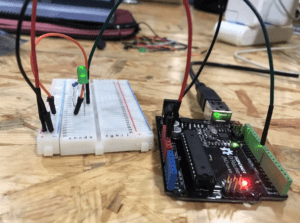
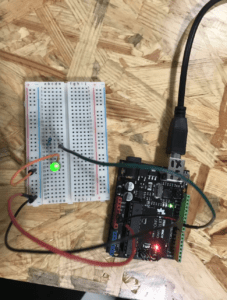
TONE
By using the command tone() we were able to input instructions that activated a sound melody through the speaker which was connected on the Breadboard, once the Arduino is reset. The familiar melody played each time we clicked the red button on the Arduino. The very simple connection was easy to follow and did not cause any delays in the making.
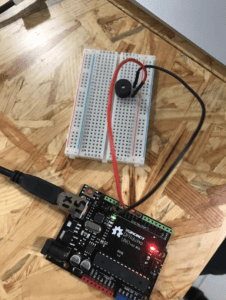
RACE THE LED
Our initial reaction to this task was to set up a system of how we will recreate this design. We decided to work from the left – to – the right (: 1) connected Breadboard Top Power to Power // 2) Breadboard Power to Arduino Power 5V (Analog) // 3) placed the Left button // 4) B Ground to A Ground (Analog) // 5) L Resistor // 6) 10 Resistor to 10 (Digital) // 7) L Resistor to to B Ground // 8) LED on Breadboard // 9) Led to A 2 (Digital) // 10) LED to Resistor // 10) 220 Resistor to B Ground // 11) speaker + speaker to B Ground ——- and then replicated on the Right side.) We ran into a problem once the code was imported because nothing was happening on the Arduino. What we don’t realised is that just like any other game, we had to “click play” or set up to play (as the computer cannot read human mind (as for now)), once we knew how to open the output sourcing window to begin the game, the circuit worked flawlessly. It was especially rewarding seeing this design fully functioning as we really tuned our focus in precision when creating it – which payed off. We played a few rounds, and even connected the arcade buttons to experience the game with a different interactive aspect. I personally preferred the small button on the Breadboard to the arcade ones, mostly because my partner was too good in his reactions with the arcade buttons and I could not light my LED with them even once! I have also sketched out the schematic for this circuit bellow.
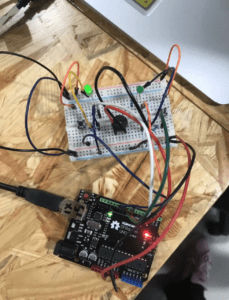
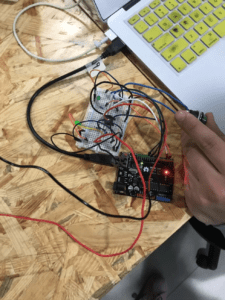
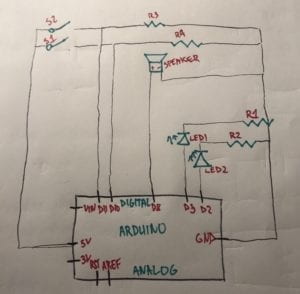
QUESTIONS
- Reflect how you use technology in your daily life and on the circuits you just built.
For this question I would actually like to reflect how my introduction to IMA has transformed my relationship and approach to technology. Never could I have imagined that art and computing could create in such a harmonious balance. I now appreciate technology and have also learned to detach from it, because it is so simple to lose ourselves in the Digital Age when every action or reaction is influenced in one way or another – by technology. It is essential to realise what information and practices are useful and exercise the brain, and what is click-bated waste. Building these circuits is really fine tuning my logical comprehension of technology; I began understanding how the currency of electricity/power flows – which all just reconfirm my own speculations on the the global world being very closely interlinked. It is very interesting to find metaphorical analogies between the recitation practices and existential life questions. My relationship with technology is rapidly changing ever since I began my higher education, and I am excited to see how I will be able to use technology to create onwards.
- If you have 100,000 LEDs of any brightness and color at your disposal, what would you make and where would you put it?
Interestingly enough I was recently fantasising about an LED light bulb project and I would like to share: So the LEDs would set up a display/ wall, a user would approach the wall, get picked up by video sensors, and after I train the AI program to light up the distinctive figure, by replicating its movement, I would like to explore it a step further, where the LEDs somehow incorporate StyleTransfer techniques to create colour patterns, the user would be able to select a function where there inputed manoeuvres would stay on the display after they have changed positions – which would allow a sort of art in the making progression, maybe the user created design could than be saved and forwarded (maybe the StyleTransfer comes in here, so after the exhibition the user would go home to open their emails and see how their inputed design was modified by the AI algorithm). Truthfully speaking I cannot quite conceptualise the number 100,000 in the context of LEDs just quite yet, therefore I would like to continue exploring this idea.